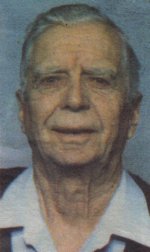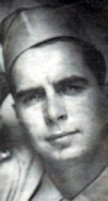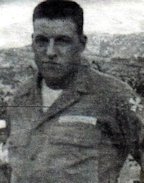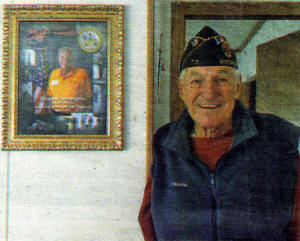Contact: Dolores (Mohr) Kenyon
E-mail: dolores@wiclarkcountyhistory.org
Surnames: VandeBerg, Harrington, Ziegler, Opelt, Struensee, Taylor, Walker, Lipscy
----Source: Clark County Press (Neillsville, Clark Co., WI) 9/30/2015
American Legion to Honor VandeBerg & Harrington (Service - 2015)
American Legion to Honor VandeBerg & Harrington

Russel VandeBerg served in the U. S. Army Air Corps from 1945 to 1947. He will be honored for his military service Monday, Oct. 5 at the Neillsville American Legion Club. (Contributed Photo)
By Todd Schmidt and Craig VandeBerg
Good friends Russel VandeBerg, 92, and Richard Harrington, 82, both of Neillsville, will be honored for their military service by the Neillsville American Legion Monday, Oct. 5.
A special award presentation will be held following 4:30 p.m. social hour and a 5:30 p.m. potluck meal.
Russel was born to Horace and Fern VandeBerg as the youngest of five children. His older siblings were Bernice, Harold, Loyd and Gale. Russel was raised in the Town of York and graduated from Neillsville High School in 1941.
By then, his oldest brother, Harold, was already serving in the U.S. Army during WWII. He endured some of the worst fighting, including the Babble of the Bulge.
His group of temporary bridge builders was surrounded until General Patton broke through to rescue them and many others. Only 12 members of his 26-man unit survived. Harold continued to advance in grade to an army captain before his discharge.
Another older brother, Loyd, began training as an Army Air Corps navigator for bombers. The war ended before Loyd completed the course, however, and he was discharged.
Horace’s health was not very good so Russel was deferred from military service to work on the farm. He helped raise a sufficient food supply for the army and civilians.
As the war was ending, Russel said to his father, “The boys are coming home soon and you can get other farm help. I am going to enlist in the Army Air Corps and see what I can make of myself.”
Russel enlisted in October 1945 but was not needed until February 1946. A few days later, Russel was at Keesler Field in Biloxi, MS, on the Gulf of Mexico.
“I thought I had died and gone to heaven with the green grass, palm trees, and warm, humid weather,” Russel said.
“When my first paycheck was issued, my name was misspelled and I waited 10 days to get paid. During the interim with no money, I noticed a guy came through the barracks each evening selling candy bars for 5 cents. I asked my bunkmate about it. He said the Post Exchange sold cartons of 24 bars for 72 cents, which was 3 cents each. I could make 48 cents a carton. I borrowed $3 and sold two cartons per night and six cartons each weekend. I was making more money on the side each month than the Army Air Corps paid me.”
Russel said basic training was actually fun for the farm boys. They were healthy an strong from farm work. They actually enjoyed going on the obstacle runs.
Some men had a problem when they had to scale the 25-ft. wooden walls strung with 2-in. rope. They lacked the upper body strength to do so.
Then there were water ponds, which had to be crossed by walking over logs. Some recruits crawled underneath the logs using their hands, arms and legs.
“We smiled again as many fell in the water,” Russel said. “I did well during most of my basic training. One exception was when they shot live ammunition over our heads at night as we crawled under barbed wire. That was a bit unpleasant.
By May, Russel’s basic training at Keesler Field was done and the Army Air Corps shipped him to Geiger Field in Spokane, WA. Spokane was nice and cool compared with Biloxi.
Again, Russel felt lucky. His primary military occupational specialty (MOS) was as an engineman operator.
Russel felt that farm boys could drive anything and knew engines. Russel had taken a typing course in high school, so he borrowed a typewriter and practiced some more. A typing speed of 31 words a minute was required to qualify as a clerk typist and he made it. This provided him with a double MOS on his record.
Around May 1946, Russel said a sergeant came into the barracks at 8 p.m. and called the names of 16 men, including his.
“We were to be ready in the morning to take part in Operation Crossroads. This was a series of nuclear weapons tests at Bikini Atoll in the Marshall Islands,” Russel noted.
The purpose of the operation was to investigate the effect of nuclear weapons on naval warships. They flew to Hawaii and waited several hours while the plane refueled. They continued on the Wake Island and then to Kwajalein’s Navy Base in the Marshall Islands
Russel went on to clarify that a huge engine that supplied electricity to the island ran out of oil and ruined its bearings. With the atomic bomb tests scheduled in a few weeks, the Navy immediately pulled a destroyer close to shore and ran a huge cable ashore for immediate electricity.
The Navy then flew in a team of 16 engineman operators and 16 D-8 Caterpillar engines with a generator attached to each.
Three engines were to run 24 hours a day at four stations. The 4th engine was to run when attention was needed on the others.
Russel was a bit older than the other guys, so he was made the temporary sergeant in charge of his shift of men. Each sergeant in charge had a vehicle to drive to his four stations and his duties included light record keeping.
Russel lamented, “I was caught speeding one time and was assigned to a work detail loading a ship. They would swing a huge net full of boxes into a ship’s hold and we would stack them in place. Pack your boxes well.”
Three atomic bombs were to be exploded in Operation Crossroads. Ninety-five target ships were assembled in Bikini Lagoon after all local natives agreed to be evacuated to other islands.
“Able,” the first air burst test, caused less than the expected amount of damage, as it missed its aim point.
“Baker,” the second underwater test, caused extensive contamination of the target feet.
“Charlie,” a third deepwater test, was canceled largely because the Navy was unable to decontaminate the target ships after the “Baker” test.
The Navy soon had the big engine repaired and the Engineman Operator Team was no longer needed. They were sent home on a Kaiser Shipyard Liberty Ship.
Although these cargo ships were 441-feet long, they bobbed in the water like a cork. Most of the guys got so sea sick they thought they were going to die.
“I managed to endure better but still had a bad headache for days. Finally, our team arrived back stateside, and we returned to Geiger Field in Spokane.” Russel said.
Russel was made sergeant in charge of the base post office. Attaining the rank of sergeant in just over a year was fast movement.
“It felt good,” Russel said.
Russel and his buddies found adequate time for recreation. They would go to Mt. Spokane. Russel also worked as a ticket seller at the base theatre.
“As a ticket seller, I found myself making more money again than the Army Air Corps paid me in wages,” Russel said.
Russel was discharged the first week in July 1947 at Ft. George Wright, WA, near Geiger Field.
“I got paid per diem for the trip home. I saved that money by finding an Air Force plane bound for an airfield in Wyoming. I hitched a free plane ride there with two other discharged servicemen,” Russel recalled.

Russel VandeBerg
(Contributed Photo)
Late the next day, with a storm brewing in the west, they hailed a Greyhound Bus and got a ride into Chicago. Russel then boarded a Greyhound Bus to Appleton. His brother, Gale, picked him up for an overnight stay.
Gale took Russel to the outskirts of Appleton. He then hitchhiked back home to Neillsville.
Russel noted that WWII began Dec. 7, 1941, with the Japanese bombing of Pearl Harbor. It ended Sept. 2, 1945, with Japan’s unconditional surrender aboard the battleship USS Missouri in Tokyo Bay.
The WWII Victory Medal was awarded to any member of the U. S. Military who served on active duty between Dec. 7, 1941, and Dec. 31, 1946, when President Truman declared an official end of the hostilities.
“Although I am proud to have received the medal, I am acutely aware of the sacrifices made by my fellow servicemen and women in defense of the United States during their WWII military service, “Russel said.
Russel returned to Neillsville with the goal of eventually working for the U. S. Postal Service.
Russel bought a 100-acre farm in the Township of York. He wanted nothing to do with dairy cows on his farm and paid Horace 4 cents a mile to use his car.
Russel met Erline Ziegler in 1948 at the Silver Dome Ballroom outside Neillsville. They were married in December 1950.
In 1951, Russel passed the U. S. Postal Service Civil Service Test. After several years of successful farming, Russel bought another 100-acre farm.
Russel’s family lived in the Town of York for seven years before moving to Neillsville. In 1958, Russel bought the farm just south of the Neillsville Golf Course where they raised a family of six children: Bruce, Craig, Mark, Marcia, Robert and Renee.
Russel worked double time by farming up to 360 crop acres of sweet corn and sweet peas for the Loyal Cannery. He also raised 85 head of Hereford beef cattle while continuing his postal career as a rural carrier.
Russel was instrumental in several Neillsville community projects. He had all his farms in the Soil Bank for five years during the 1960s, which granted him the opportunity to do other things.
Russel’s greatest civic accomplishment involved expanding Neillsville High School. Russel and Bob Opelt convinced school officials to buy Joe Struensee’s entire farm. The school board required a $3.5 million bond issue to finance the expansion project.
All Neillsville service clubs were asked to suggest one person to head the school building program. The Rotary Club chose Russel as its chairman.
A huge amount of money for schools was available from state and federal government sources if approval was granted. A referendum was passed, and the government financed two-thirds of the school expansion costs. Neillsville high School has expanded once more since then and is an icon within the community.
Russel was head of the Tri-County Committee for Higher Education. Clark, Wood and Marathon counties formed the group to bring college education facilities closer to the people of Wisconsin.
UW-Madison had 30,000 students by the early 1970s and seemed too big and expensive to many. The committee wanted the first two years of college to be available to citizens at cities throughout the state to relieve pressure on Madison.
Russel coordinated his efforts with the Neillsville Rotary Club. Several cities were ultimately chosen for college sites, which allowed students to attend school closer to their homes. It allowed citizens to achieve a more economical education.
Russel also served as chairman for the Rotary Club’s “Pig Project,” which helped Neillsville High School students make money for themselves.
In cooperation with the high school agriculture teacher, the Rotary Club provided four students with four feeder pigs annually. The project became popular and grew fast.
The project only cost the Rotary Club $160 per year but resulted in tremendous favorable media publicity. Neillsville soon became known as “The Feeder Pig Capital of the World.”
Soon, many people were selling feeder pigs across Central Wisconsin and the Midwest. The project proved very beneficial as extra income to the dairy farms.
Russel was also active in the Neillsville Parent Teacher’s Association (PTA), the Neillsville Masonic Lodge as a Master Mason and in the American Legion.
In 1978, Russel sold his farm and remodeled a house in the Town of Levis. He was handy at almost anything and enjoyed upgrading construction.
He often commented, “It’s better since I’ve been here.” His helping ways improved many things wherever he lived.
In 1980, Russel retired from the Postal Service with 30 years of service. Russel and Erline have travelled to every state and over 15 foreign countries.
Winters were spent in dry, warm climates such as four years in Lake Havasu, AZ, 14 years in Boulder City, NV, and the past seven years in Mesa, AZ.
They didn’t forget Neillsville, though, and returned to spend each summer with family and friends.
Russel always worked a lot, but he played a good share in later years. Ski trips were enjoyed to numerous states. Russel also enjoyed frequent fishing trips to Canada with is sons and friends for several decades. Golfing was for socializing and his score was irrelevant. Dancing was also a joy for him.
Russel has enjoyed life to the fullest and has comment, “May I die in the center of the floor during the last dance of the evening.” May it be so...

Richard Harrington
(Contributed Photo)
Richard, a 1952 graduate of Neillsville High school, was drafted into the U. S. Army in 1953 at the age of 20.
Before entering the service, Richard peddled papers, set pins at the local bowling alley and did chores for various farmers.
He and five other recruits from the Neillsville area were sent to Chicago for processing. After being held over for some time, Richard was sent to Ft. Campbell, KY, for basic training.
Richard was assigned to a division of the 3rd Army. They received schooling and training in heavy weapons firing.
“We were scared of nothing,” Richard said. “But I did lose some hearing.”
He said the recruits were worked hard in basic training. During a training exercise, two men were killed in a mortar accident.
“They really put it to us,” Richard said, “We marched half the night and cleaned the barracks until they were spot-on clean. I was in good shape, which helped a lot.”
Richard was sent back to Chicago for a short leave. He hitchhiked to Klondike Corners, where his mother picked him up.
“I ordered a hamburger and had a couple of beers,” he recalled. “The waitress told me my money was no good there, because I was in the Army.”
The troops were then shipped to Japan for further schooling. They learned how to build bridges and how to blow them up.
Richard said the ships “bobbed around in the ocean” for a while because the Army was unsure about their assignment. His ship eventually landed in Seoul, Korea.
Richard had his MOS changed to plumbing. His unit performed various tasks, including running a water line 150 ft. up a mountain, building a dam, laying timbers for a bridge, constructing a set of bathrooms and building a clay tennis court for General Max Taylor.
They also built a cement 30-ft. x 400-ft. maintenance and storage building for tanks.
“I couldn’t just sit around, I always had to be doing something,” Richard said.
The troops took turns on supervision and guard duty. Richard said he didn’t have orders for a while in Korea and he acted as a civilian. The rank was frozen, so corporals (Richard’s highest attainable rank) had to do the sergeant’s work.
In 1955, his unit was shipped back to Camp Pendleton in San Diego, CA, and then to Chicago, where Richard received his honorable discharge.
“I decided when I came home from Korea there was no way in hell I was going to milk cows,” Richard said.
He moved to Milwaukee, where he worked in supervision at a steel foundry, a construction company and a 592-bed nursing home.
While in Milwaukee, Richard was an active member of the Lions Club, serving as treasurer for many years. He spearheaded a number of Lions-sponsored skiing trips for handicapped youth. Richard joined the American Legion in Milwaukee 29 years ago. Richard had prostate cancer surgery in 1995 and was forced to retire.
“My nurse asked me why I still wanted to keep working,” he said, “I told her I actually didn’t feel that bad.”
Richard and his family then moved to a home outside of Neillsville along STH 95.
He and his wife, Janet (Seelow) were married in 1955. They had two sons, Steve, who passed away in June 2013, and Mark. They have six grandchildren, with a granddaughter expecting twins later this year.
Richard’s family gave him lifetime memberships in the American Legion and VFW as Christmas gifts. He served for three years as commander of the Neillsville American Legion and received a certificate of appreciation for servicing as a member of the Color Guard, Honor Guard and Firing Squad.
On Friday nights, he and Janet worked with Bernie and Delores Walker in the kitchen at the former Legion Hall on Hewett Street.
Richard was part of the Building Committee for the new Legion Hall. Once it was built, he baked fish on Friday nights, cooked chicken for weddings and tended bar on Mondays for about three years.
“It cost us about a million dollars to build the new place, which was a lot more than we thought,” Richard said. “I’m concerned about losing it due to too much overhead and expenses.”
Richard has spent a lot of time volunteering at The Highground, mainly laying blocks for Legacy Stones with fellow Legion member Don Lipscy, who recently passed away.
“Don always told me I knew what he needed for materials before he did,” Richard said. “We really enjoyed working together.”
After his retirement, Richard had fun hunting, fishing and traveling. He and Janet have trekked to Phoenix, AZ, with their motor home 11 times during the winter months. They have been in every state in the Union and have toured seven islands via cruise ship.
Richard was privileged to travel on Never Forgotten Honor Flight XV out of Central Wisconsin Airport April 14, 2014.
Attendees received a welcome package including two nights of free lodging. A huge snowstorm blanketed the Wausau are the night before scheduled departure, and another plane had to be sent from Minneapolis. The flight left about seven hours behind schedule.
The group toured various monuments in Washington, DC, and the Arlington Cemetery.
“They were having a funeral that day,” Richard recalled. “The horse-drawn wagons they used were very interesting to see.”
Richard said the honor Flight trip brought back many memories.
“I felt good about being in the Army and serving my country,” Richard said. “I enjoyed my time in the service.”
Richard keeps up on current affairs. He said the country could do a better job in the area of foreign policy.
“They keep worrying about North Korea,” he said. “I don’t think they have much trouble with them. Many people in the Third World countries really don’t care about human life. I’m not satisfied with President Obama. His vision for the country is different. It seems like he wants to do everything his way.”

Richard Harrington served in the U.S. Army from 1953 to 1955. He will be honored for his military service Monday, Oct. 5, at the Neillsville American Legion Club. (Photo by Todd Schmidt/Clark County Press)
